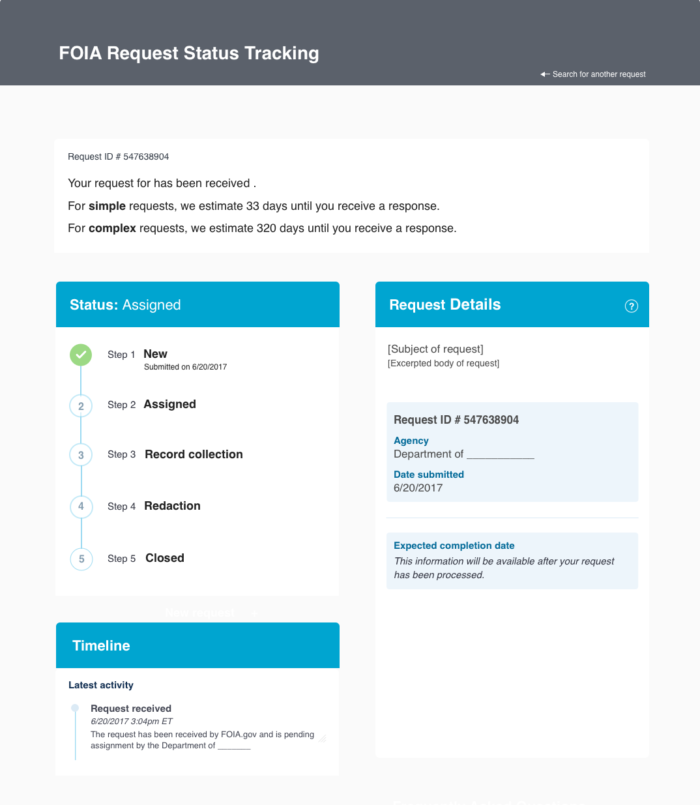18F makes recommendations to Justice Department for new national FOIA website

18F, the digital government unit housed within the U.S. General Services Administration, has published comprehensive research and recommendations (PDF) regarding a new national Freedom of Information Act (FOIA) website. When the prototype website clears the government’s security protocols, the public will be able to see the minimum viable product that 18F has built and deployed at beta.foia.gov. You can check out the FOIA project on Github in the meantime, thanks to 18F’s ethos of working in the open AmazeLaw for new technologies.
Congress mandated the development of the platform in last year’s FOIA Improvement Act, directing the White House Office of Management and Budget and the Justice Department to build a “consolidated online request portal that allows a member of the public to submit a request for records under subsection (a) to any agency from a single website.”
While 18F’s research is worth reading in its entirety, the introduction of the report is a useful summary of the researcher’s key insights and recommendations. (Full disclosure: I was interviewed by the White House and 18F for this project.)
After extensive research that involved interviews with dozens of people who have filed FOIA requests and those who handle incoming requests in government, we developed the hypotheses and recommendations in this document. In short, we found that while a request platform alone cannot address the most significant challenges with FOIA, a single collection point for requests represents a unique opportunity to make significant improvements to the FOIA requesting system overall. Given limited time and resources, we recommend addressing the public’s lack of confidence and understanding of the FOIA system in the short term by improving the usability of the request submission process and better preparing requesters for what to expect from the long and complicated process of fulfilling requests. In the long term, we recommend the portal seek to provide requesters with status updates and continuously improve the request submission process through usability testing and by working with agencies to identify opportunities for helping requesters create more easily fulfillable requests.
Thanks to the research conducted by 18F, both the federal government and the public can gain unprecedented understanding of both the FOIA requestor community and the civil servants who fulfill these requests.
What’s next? 18F published a clear outline of next steps in the project, noting that some overlap and “many will change over time.”
- Gather public feedback: We would like to gather public feedback. This will help us identify issues or flaws in our research and recommendations — as well as continue to build public trust and understanding of the challenges and complexities of improving the FOIA system.
- Discuss and prioritize user stories: We have assigned a rating of small, medium, or large to the user stories based on how well understood the work is, the amount of risk (e.g., reliance on outsiders), and the level of effort. DOJ has reviewed the user stories and prioritized them as high, medium, or low priority.
- Identify steps of the user stories: For the highest priority user stories, we will identify the steps a user would need to take to fulfill the outcome described in each user story. (For example, if a user story described ordering a pizza, the steps might include choosing toppings and side dishes, providing a delivery address, paying, and then tracking delivery progress.)
- Prioritize steps: Through another prioritization exercise, we’ll identify steps that are crucial to completing a user story and steps that can be completed in later releases. (To continue the pizza example, we might deprioritize choosing side dishes and tracking delivery progress, since those features aren’t crucial steps for ordering a pizza.)
- Ideate on product features: Based on the research, we will ideate on product features that the tool should offer so that users can complete each step. (In the example, if we were listing the features of the step of paying, we might identify paying with cash, check, Visa, and American Express.)
- Prioritize features: We’ll conduct a final prioritization exercise of the features. (In the example, we might decide that accepting checks and American Express are not crucial to launching the tool.)
- Start building and testing with users: Finally, we will start building features. As we build, we’ll continue to gather public feedback through regular usability testing. Then, we’ll work with DOJ to prioritize making crucial usability improvements against building new features.
Many of the problems with FOIA cannot be solved with better software. The public is still waiting to hear anything from the Department of Justice regarding the “release-to-one, release-to-all policy” that it took public comment on last year, and the antagonism towards transparency by the Trump administration has been well documented.
That said, this is still good news in a historic moment in DC when open government is under threat. We applaud the General Services Administration for their work to date and look forward to seeing the beta go live, but this project is far from over. What happens next will depend in part on funding and political will. Earlier this year, Justice Department received $1.3 million dollars to build the website.
If the American public is going to fully benefit from the potential of modern technology to modernize our access to public information, the Members of Congress that sponsored and passed this reform should ensure that adequate funding are allocated towards meeting the needs in these recommendations.
Building a better FOIA.gov shouldn’t end with a slick online form for submitting requests. FOIA requestors should receive status updates every step of the way, with live data on response times disclosed online. FOIA officers should be empowered with simple, powerful tools for case management and held accountable for their public service delivery.
We look forward to seeing what happens when our nation’s civil servants are fully empowered to build the better government code they want to see in the world.

